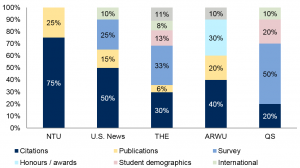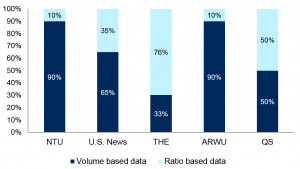University of Toronto is often in the news because of its international rankings, but how are the rankings produced and how does U of T compare?
While rankings are only one measure of our excellence and they do not tell the full story of the University’s success, they are nevertheless important and continue to influence prospective students, other academics, and government policy makers.
University rankings are widely publicised and popular in part because of their simplicity. They take a range of different indicators and combine them using a weighting schema to create a single score and ranking position.
How do we rank?
There are many rankings that are of relevance to U of T, but the following are the five major international rankings that we track:
Times Higher Education (THE) –World University Rankings
QS – World University Rankings
Shanghai Ranking – Academic Ranking of World Universities (ARWU)
National Taiwan University (NTU)- Performance Ranking of Scientific Papers for World Universities
U.S. News & World Report – Best Global Universities
The following table shows the results of the top 25 international institutions ordered by their average performance across the five major rankings. U of T is ranked #1 in Canada for all five of the rankings, and is frequently ranked among the top 10 public universities in the world.
Global University Ranking Results (2018)
| Institution | NTU | U.S. News | THE | ARWU | QS |
| Harvard University | 1 | 1 | 6 | 1 | 3 |
| Stanford University | 2 | 3 | 3 | 2 | 2 |
| University of Oxford | 5 | 5 | 1 | 7 | 5 |
| Massachusetts Institute of Technology | 9 | 2 | 4 | 4 | 1 |
| University of California – Berkeley | 14 | 4 | 15 | 5 | 27 |
| University of Cambridge | 10 | 7 | 2 | 3 | 6 |
| University of California – Los Angeles | 11 | 13 | 17 | 11 | 32 |
| Columbia University | 12 | 8 | 16 | 8 | 16 |
| Johns Hopkins University | 3 | 12 | 12 | 18 | 21 |
| University of Chicago | 20 | 14 | 10 | 10 | 9 |
| Yale University | 18 | 11 | 8 | 11 | 15 |
| University of Washington – Seattle | 6 | 10 | 28 | 14 | 66 |
| California Institute of Technology | 57 | 6 | 5 | 9 | 4 |
| University of Pennsylvania | 12 | 16 | 12 | 16 | 19 |
| Imperial College London | 15 | 18 | 9 | 24 | 8 |
| University College London | 8 | 21 | 14 | 17 | 10 |
| University of Michigan – Ann Arbor | 7 | 18 | 20 | 27 | 20 |
| University of Toronto | 4 | 20 | 21 | 23 | 28 |
| Cornell University | 22 | 23 | 19 | 12 | 14 |
| Duke University | 19 | 22 | 18 | 26 | 26 |
| University of California – San Diego | 17 | 17 | 30 | 15 | 41 |
| Princeton University | 85 | 9 | 7 | 6 | 13 |
| Northwestern University | 24 | 24 | 25 | 25 | 28 |
| ETH Zurich | 48 | 25 | 11 | 19 | 7 |
| University of British Columbia | 25 | 29 | 37 | 43 | 47 |
The international rankings also rank universities across broad disciplinary fields.
UNIVERSITY OF TORONTO’S TIMES HIGHER EDUCATION SUBJECT RANKINGS RESULTS (2018)
| THE – Subject | Global Rank | Rank in Canada | Rank Among Public Universities |
| Arts & Humanities | 18 | 1 | 10 |
| Education | 13 | 1 | 9 |
| Law | 11 | 1 | 6 |
| Psychology | 19 | 2 | 9 |
| Business & Economics | 28 | 2 | 17 |
| Clinical, Pre-Clinical & Health | 13 | 1 | 8 |
| Computer Science | 18 | 1 | 11 |
| Engineering & Technology | 31 | 1 | 22 |
| Life Sciences | 24 | 1 | 12 |
| Physical Sciences | 26 | 1 | 17 |
| Social Sciences | 25 | 1 | 14 |
UNIVERSITY OF TORONTO’S QS FIELD RANKINGS RESULTS (2018)
| QS – Field | Global Rank | Rank in Canada | Rank Among Public Universities |
| Arts & Humanities | 22 | 1 | 14 |
| Engineering & Technology | 43 | 1 | 36 |
| Life Sciences & Medicine | 13 | 1 | 8 |
| Natural Sciences | 23 | 1 | 17 |
| Social Sciences & Management | 34 | 1 | 26 |
Shanghai and QS also provide rankings for narrow subject areas. Highlights include:
- Shanghai Subject Rankings:
- U of T is among the top 50 in 35 subjects. The same number of subjects as Berkeley. Only Harvard, Stanford and Michigan have more.
- U of T was ranked in the top 10 in seven subjects: Automation & Control (7th), Human Biological Sciences (6th), Medical Technology (4th), Public Health (10th), Psychology (2nd), Sociology (8th), Management (9th)
- QS Subject Rankings:
- U of T is among the top 25 in 31 subjects. Alongside Cambridge, Oxford, Berkeley, UCLA, Stanford and Harvard
- U of T was ranked in the top 10 in eight subjects: Computer Science (10th), Geography (9th), Nursing (2nd), Anatomy (8th), Anthropology (8th), Social Policy (8th), Theology (8th, tied), and Sports-related subjects (6th).
How does U of T use ranking results?
The University uses ranking results as a demonstration of our excellence in research, both locally and globally. Ranking results support the University’s efforts to tell our story when it comes to:
- Recruitment of faculty and students
- Advancement opportunities
- Advocacy with government officials
Why are there different results among the major rankings?
The results vary depending on the metrics included in each of the rankings, the differing weights assigned to the indicators and the statistical scoring methodology that is utilized by the ranking organizations. Because of the choice of indicators, the size of the university has more significance in some rankings than others.
The following chart maps the metrics employed by each ranking into seven categories to provide a comparison of the similarities and differences among the methodologies:
And the following chart shows the significance of the size-dependent indicators vs. ratio-based indicators:
Where do the ranking organizations get their data?
Each ranking is different but a significant proportion of each ranking is based on publication and citation data from 3rd party sources. Many of rankings also utilize reputation survey data. They conduct surveys of published academics and the participants are asked to nominate which universities they consider the best in their field. QS and THE also acquire data from universities directly (see below for more details). ARWU utilizes data from various public sources such as the list of Nobel Prize winners.
What data are provided by the University to the ranking organizations?
The majority of data underlying the ranking results are from third party data sources, however for THE and QS some information is provided by the universities. Examples of their data requests include: enrolment counts, degrees awarded, proportion of staff and students that are international, and financial information. The University of Toronto works carefully with each organization to fulfill the data requirements accurately
How do faculty and staff members participate in rankings?
QS, THE, and U.S. News use data from reputation surveys of academics, and you may receive an invitation to participate in one of their surveys. Although survey participants typically cannot select their own institution, academics at other institutions may select U of T.
As a result, fostering and maintaining positive relationships with our collaborators, partners and alumni in academic positions may help us maximise our reputational standing. Expanding our engagement in global research networks brings many benefits – including increasing awareness of the world-class quality of U of T’s scholarship.
Publishing highly cited papers can be impactful in many ways, including having a positive effect on rankings outcomes. Making sure that each paper is clearly affiliated with the University of Toronto will help the ranking organizations include as many of our research outputs as possible.
Are there other international rankings of importance?
There are many rankings published every year, and there are constantly new ones being introduced. Many contain valuable information, there are several mission focused rankings that we also monitor:
- THE’s Reputation Rankings: U of T was ranked 1st in Canada and 22nd in the world.
- THE’s Global Employability Ranking: U of T was ranked 1st in Canada and 13th in the world.
- QS’s Graduate Employability Rankings: U of T was ranked 1st in Canada and 12th in the world.
- Reuters’ Top 100 the World’s Most Innovative Universities: U of T was ranked 1st in Canada and 35th in the world.
- Macleans ranking of Canadian universities, by reputation: U of T was ranked 1st in Canada
Note: some rankings are published using a cover date in the future of the actual date, for example, the QS ranking published in June 2018 is branded as the 2019 ranking. This article uses the year in which the ranking was published, not the cover date assigned by the ranking organization.

